Report on Counselling: Techniques, Ethics, and Client Case Analysis
VerifiedAdded on 2019/12/17
|10
|3350
|410
Report
AI Summary
This report delves into the multifaceted world of counselling, examining various techniques and ethical considerations crucial for effective practice. It begins by outlining the fundamental role of a counsellor, emphasizing empathy, active listening, and the importance of enabling clients to find their own solutions. The report then addresses common challenges faced by counsellors, including client dishonesty and resistance, and explores diverse client issues such as child protection, suicide prevention, domestic violence, mental health concerns, and substance abuse. Ethical and legal issues, including professional responsibility, dual relationships, confidentiality, and adherence to ethical codes, are also discussed. The report highlights the significance of congruence in the counsellor-client relationship and introduces existential psychotherapy. Furthermore, it includes an analysis of a client case study, proposing appropriate therapeutic approaches like humanistic, group, relationship, mindfulness-based, and EMDR therapies, along with the utilization of emotional tension release techniques. The report concludes by emphasizing the importance of specific counselling techniques and the need for tailored interventions based on individual client needs.
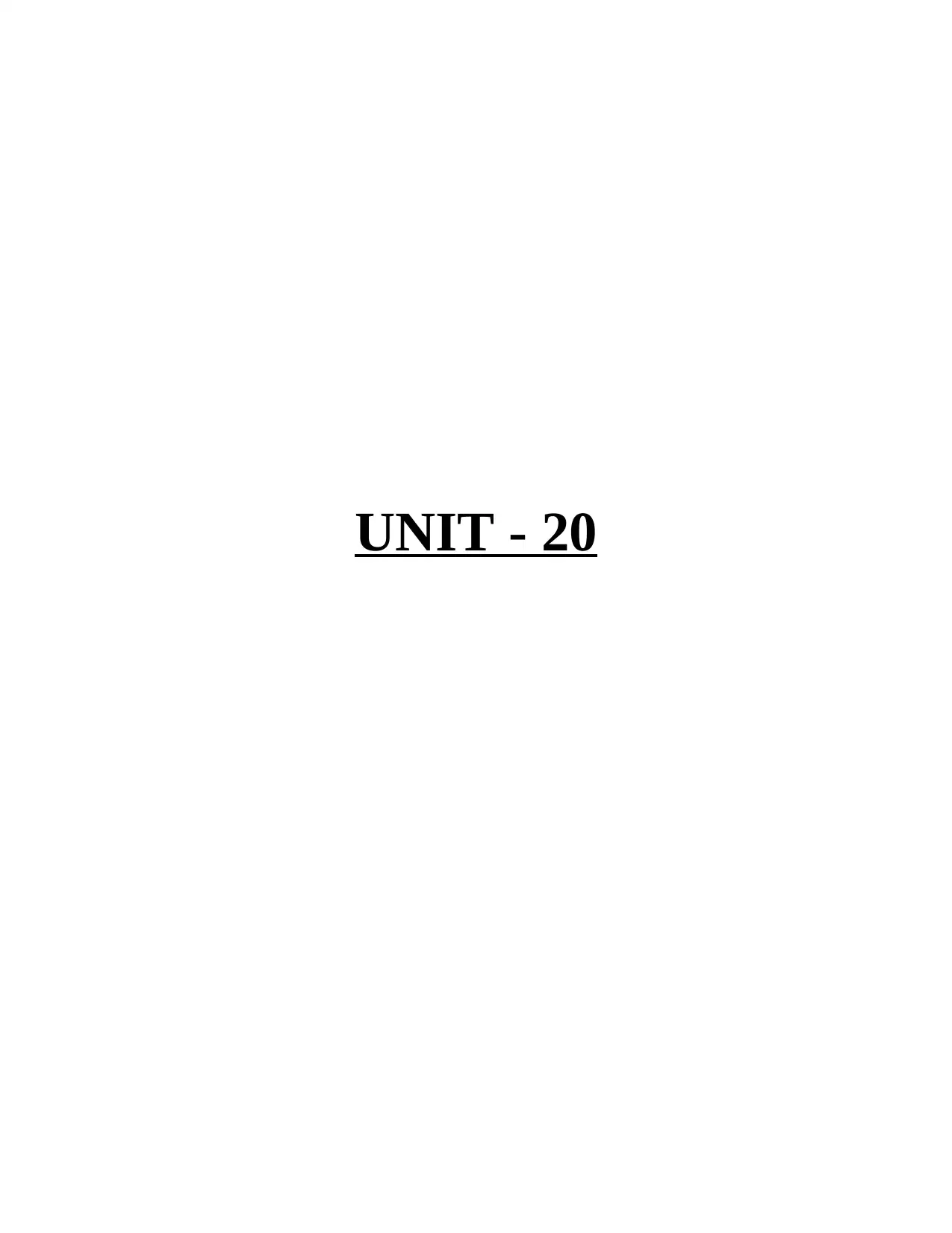
UNIT - 20
Paraphrase This Document
Need a fresh take? Get an instant paraphrase of this document with our AI Paraphraser
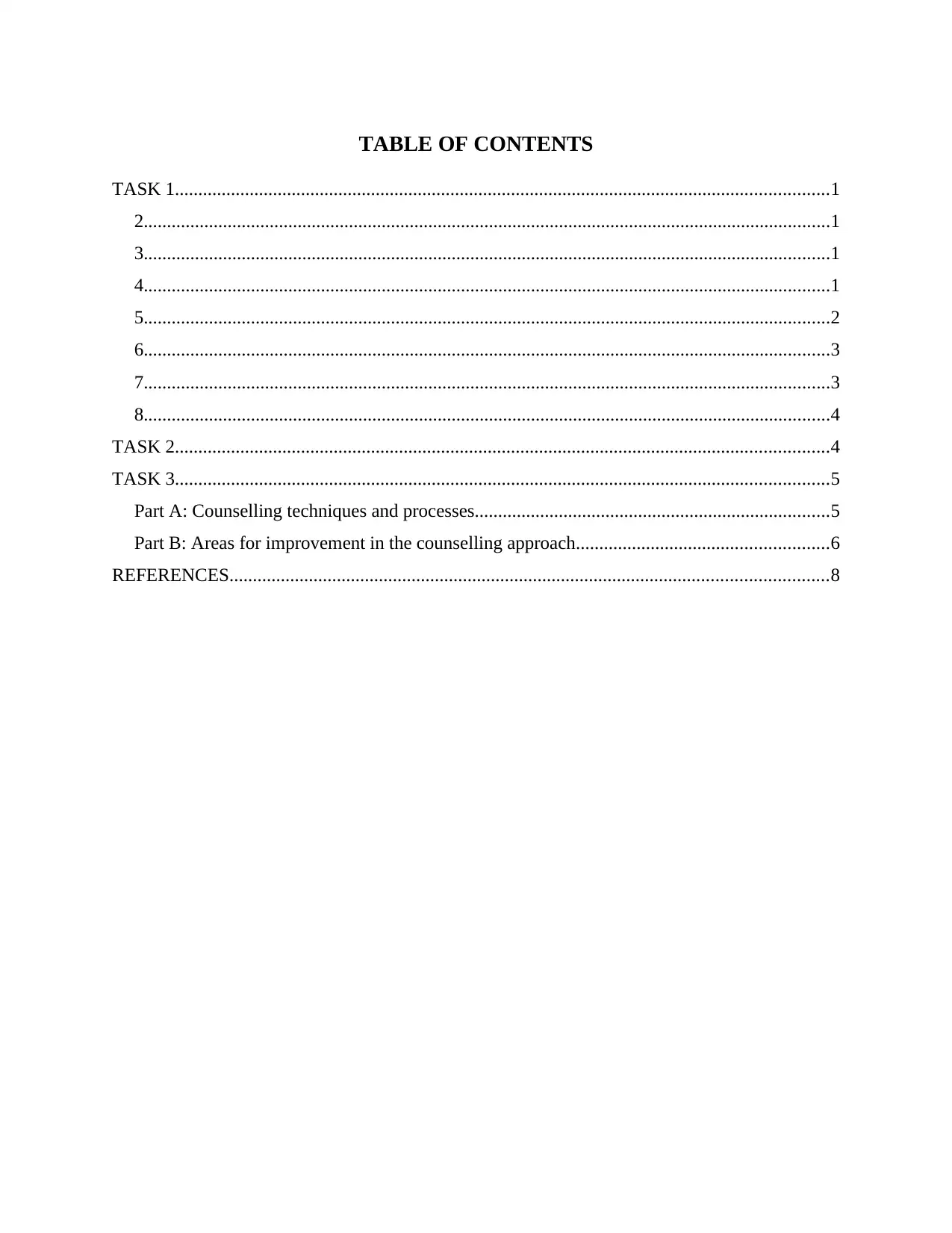
TABLE OF CONTENTS
TASK 1............................................................................................................................................1
2...................................................................................................................................................1
3...................................................................................................................................................1
4...................................................................................................................................................1
5...................................................................................................................................................2
6...................................................................................................................................................3
7...................................................................................................................................................3
8...................................................................................................................................................4
TASK 2............................................................................................................................................4
TASK 3............................................................................................................................................5
Part A: Counselling techniques and processes............................................................................5
Part B: Areas for improvement in the counselling approach......................................................6
REFERENCES................................................................................................................................8
TASK 1............................................................................................................................................1
2...................................................................................................................................................1
3...................................................................................................................................................1
4...................................................................................................................................................1
5...................................................................................................................................................2
6...................................................................................................................................................3
7...................................................................................................................................................3
8...................................................................................................................................................4
TASK 2............................................................................................................................................4
TASK 3............................................................................................................................................5
Part A: Counselling techniques and processes............................................................................5
Part B: Areas for improvement in the counselling approach......................................................6
REFERENCES................................................................................................................................8
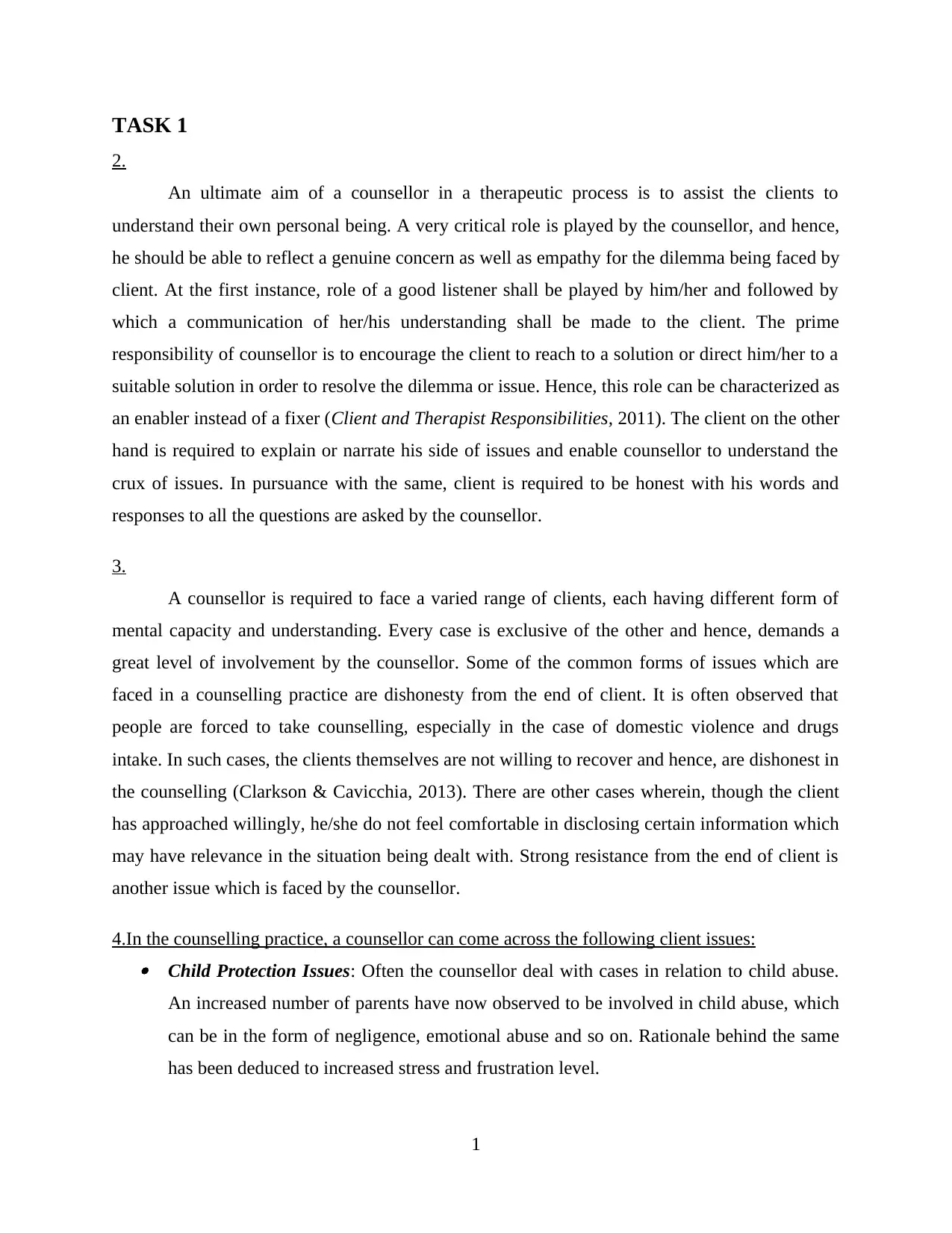
TASK 1
2.
An ultimate aim of a counsellor in a therapeutic process is to assist the clients to
understand their own personal being. A very critical role is played by the counsellor, and hence,
he should be able to reflect a genuine concern as well as empathy for the dilemma being faced by
client. At the first instance, role of a good listener shall be played by him/her and followed by
which a communication of her/his understanding shall be made to the client. The prime
responsibility of counsellor is to encourage the client to reach to a solution or direct him/her to a
suitable solution in order to resolve the dilemma or issue. Hence, this role can be characterized as
an enabler instead of a fixer (Client and Therapist Responsibilities, 2011). The client on the other
hand is required to explain or narrate his side of issues and enable counsellor to understand the
crux of issues. In pursuance with the same, client is required to be honest with his words and
responses to all the questions are asked by the counsellor.
3.
A counsellor is required to face a varied range of clients, each having different form of
mental capacity and understanding. Every case is exclusive of the other and hence, demands a
great level of involvement by the counsellor. Some of the common forms of issues which are
faced in a counselling practice are dishonesty from the end of client. It is often observed that
people are forced to take counselling, especially in the case of domestic violence and drugs
intake. In such cases, the clients themselves are not willing to recover and hence, are dishonest in
the counselling (Clarkson & Cavicchia, 2013). There are other cases wherein, though the client
has approached willingly, he/she do not feel comfortable in disclosing certain information which
may have relevance in the situation being dealt with. Strong resistance from the end of client is
another issue which is faced by the counsellor.
4.In the counselling practice, a counsellor can come across the following client issues: Child Protection Issues: Often the counsellor deal with cases in relation to child abuse.
An increased number of parents have now observed to be involved in child abuse, which
can be in the form of negligence, emotional abuse and so on. Rationale behind the same
has been deduced to increased stress and frustration level.
1
2.
An ultimate aim of a counsellor in a therapeutic process is to assist the clients to
understand their own personal being. A very critical role is played by the counsellor, and hence,
he should be able to reflect a genuine concern as well as empathy for the dilemma being faced by
client. At the first instance, role of a good listener shall be played by him/her and followed by
which a communication of her/his understanding shall be made to the client. The prime
responsibility of counsellor is to encourage the client to reach to a solution or direct him/her to a
suitable solution in order to resolve the dilemma or issue. Hence, this role can be characterized as
an enabler instead of a fixer (Client and Therapist Responsibilities, 2011). The client on the other
hand is required to explain or narrate his side of issues and enable counsellor to understand the
crux of issues. In pursuance with the same, client is required to be honest with his words and
responses to all the questions are asked by the counsellor.
3.
A counsellor is required to face a varied range of clients, each having different form of
mental capacity and understanding. Every case is exclusive of the other and hence, demands a
great level of involvement by the counsellor. Some of the common forms of issues which are
faced in a counselling practice are dishonesty from the end of client. It is often observed that
people are forced to take counselling, especially in the case of domestic violence and drugs
intake. In such cases, the clients themselves are not willing to recover and hence, are dishonest in
the counselling (Clarkson & Cavicchia, 2013). There are other cases wherein, though the client
has approached willingly, he/she do not feel comfortable in disclosing certain information which
may have relevance in the situation being dealt with. Strong resistance from the end of client is
another issue which is faced by the counsellor.
4.In the counselling practice, a counsellor can come across the following client issues: Child Protection Issues: Often the counsellor deal with cases in relation to child abuse.
An increased number of parents have now observed to be involved in child abuse, which
can be in the form of negligence, emotional abuse and so on. Rationale behind the same
has been deduced to increased stress and frustration level.
1
⊘ This is a preview!⊘
Do you want full access?
Subscribe today to unlock all pages.

Trusted by 1+ million students worldwide
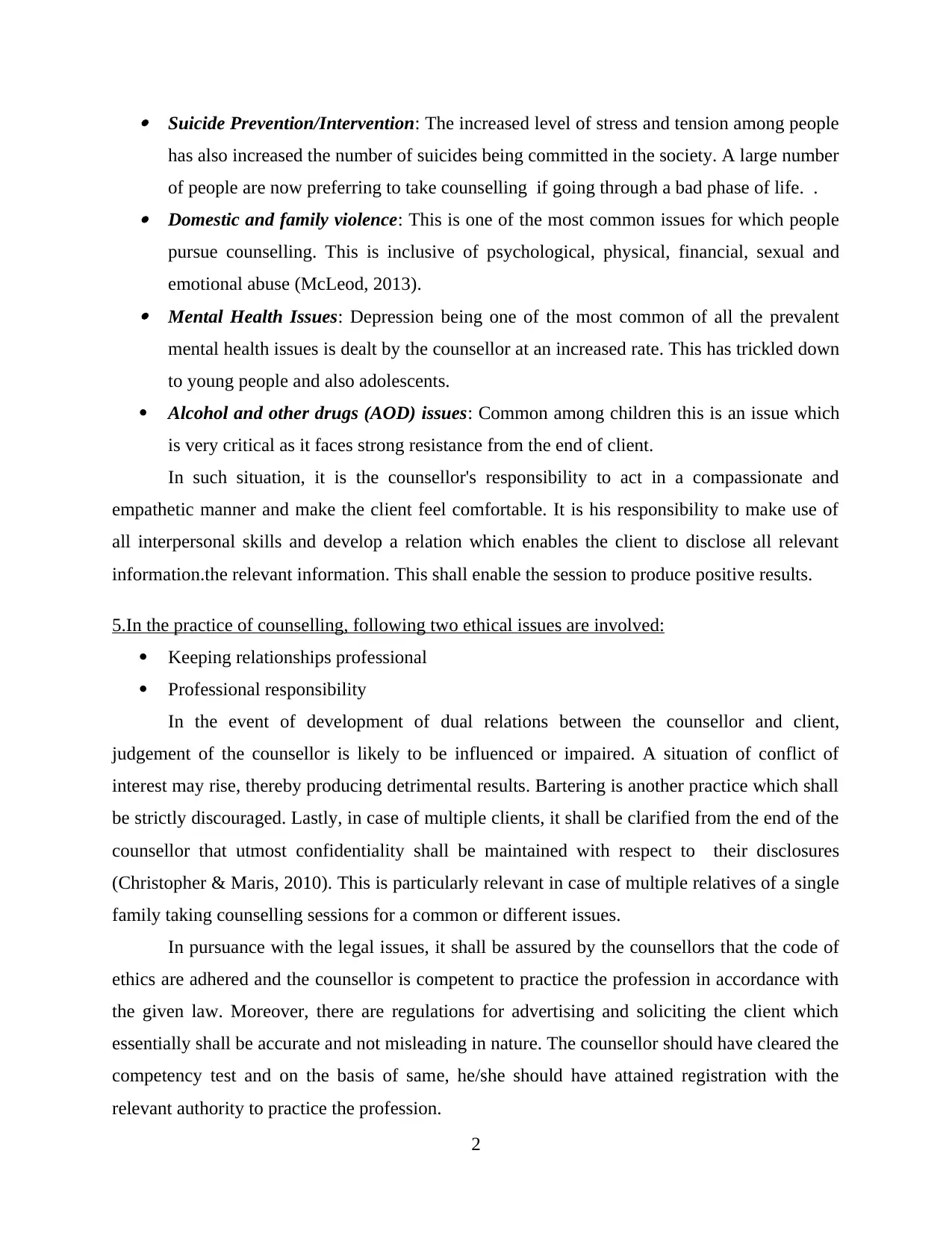
Suicide Prevention/Intervention: The increased level of stress and tension among people
has also increased the number of suicides being committed in the society. A large number
of people are now preferring to take counselling if going through a bad phase of life. . Domestic and family violence: This is one of the most common issues for which people
pursue counselling. This is inclusive of psychological, physical, financial, sexual and
emotional abuse (McLeod, 2013). Mental Health Issues: Depression being one of the most common of all the prevalent
mental health issues is dealt by the counsellor at an increased rate. This has trickled down
to young people and also adolescents.
Alcohol and other drugs (AOD) issues: Common among children this is an issue which
is very critical as it faces strong resistance from the end of client.
In such situation, it is the counsellor's responsibility to act in a compassionate and
empathetic manner and make the client feel comfortable. It is his responsibility to make use of
all interpersonal skills and develop a relation which enables the client to disclose all relevant
information.the relevant information. This shall enable the session to produce positive results.
5.In the practice of counselling, following two ethical issues are involved:
Keeping relationships professional
Professional responsibility
In the event of development of dual relations between the counsellor and client,
judgement of the counsellor is likely to be influenced or impaired. A situation of conflict of
interest may rise, thereby producing detrimental results. Bartering is another practice which shall
be strictly discouraged. Lastly, in case of multiple clients, it shall be clarified from the end of the
counsellor that utmost confidentiality shall be maintained with respect to their disclosures
(Christopher & Maris, 2010). This is particularly relevant in case of multiple relatives of a single
family taking counselling sessions for a common or different issues.
In pursuance with the legal issues, it shall be assured by the counsellors that the code of
ethics are adhered and the counsellor is competent to practice the profession in accordance with
the given law. Moreover, there are regulations for advertising and soliciting the client which
essentially shall be accurate and not misleading in nature. The counsellor should have cleared the
competency test and on the basis of same, he/she should have attained registration with the
relevant authority to practice the profession.
2
has also increased the number of suicides being committed in the society. A large number
of people are now preferring to take counselling if going through a bad phase of life. . Domestic and family violence: This is one of the most common issues for which people
pursue counselling. This is inclusive of psychological, physical, financial, sexual and
emotional abuse (McLeod, 2013). Mental Health Issues: Depression being one of the most common of all the prevalent
mental health issues is dealt by the counsellor at an increased rate. This has trickled down
to young people and also adolescents.
Alcohol and other drugs (AOD) issues: Common among children this is an issue which
is very critical as it faces strong resistance from the end of client.
In such situation, it is the counsellor's responsibility to act in a compassionate and
empathetic manner and make the client feel comfortable. It is his responsibility to make use of
all interpersonal skills and develop a relation which enables the client to disclose all relevant
information.the relevant information. This shall enable the session to produce positive results.
5.In the practice of counselling, following two ethical issues are involved:
Keeping relationships professional
Professional responsibility
In the event of development of dual relations between the counsellor and client,
judgement of the counsellor is likely to be influenced or impaired. A situation of conflict of
interest may rise, thereby producing detrimental results. Bartering is another practice which shall
be strictly discouraged. Lastly, in case of multiple clients, it shall be clarified from the end of the
counsellor that utmost confidentiality shall be maintained with respect to their disclosures
(Christopher & Maris, 2010). This is particularly relevant in case of multiple relatives of a single
family taking counselling sessions for a common or different issues.
In pursuance with the legal issues, it shall be assured by the counsellors that the code of
ethics are adhered and the counsellor is competent to practice the profession in accordance with
the given law. Moreover, there are regulations for advertising and soliciting the client which
essentially shall be accurate and not misleading in nature. The counsellor should have cleared the
competency test and on the basis of same, he/she should have attained registration with the
relevant authority to practice the profession.
2
Paraphrase This Document
Need a fresh take? Get an instant paraphrase of this document with our AI Paraphraser
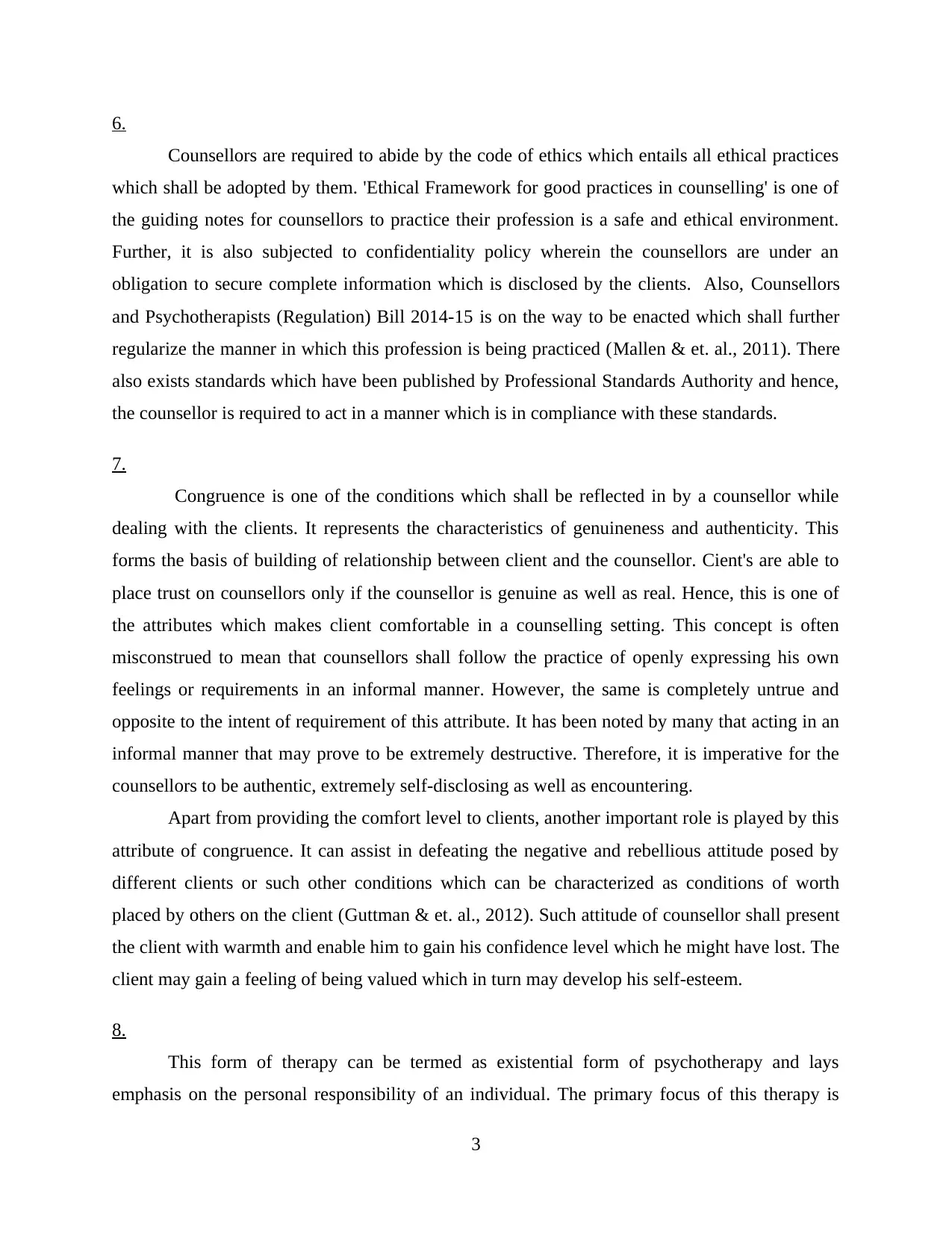
6.
Counsellors are required to abide by the code of ethics which entails all ethical practices
which shall be adopted by them. 'Ethical Framework for good practices in counselling' is one of
the guiding notes for counsellors to practice their profession is a safe and ethical environment.
Further, it is also subjected to confidentiality policy wherein the counsellors are under an
obligation to secure complete information which is disclosed by the clients. Also, Counsellors
and Psychotherapists (Regulation) Bill 2014-15 is on the way to be enacted which shall further
regularize the manner in which this profession is being practiced (Mallen & et. al., 2011). There
also exists standards which have been published by Professional Standards Authority and hence,
the counsellor is required to act in a manner which is in compliance with these standards.
7.
Congruence is one of the conditions which shall be reflected in by a counsellor while
dealing with the clients. It represents the characteristics of genuineness and authenticity. This
forms the basis of building of relationship between client and the counsellor. Cient's are able to
place trust on counsellors only if the counsellor is genuine as well as real. Hence, this is one of
the attributes which makes client comfortable in a counselling setting. This concept is often
misconstrued to mean that counsellors shall follow the practice of openly expressing his own
feelings or requirements in an informal manner. However, the same is completely untrue and
opposite to the intent of requirement of this attribute. It has been noted by many that acting in an
informal manner that may prove to be extremely destructive. Therefore, it is imperative for the
counsellors to be authentic, extremely self-disclosing as well as encountering.
Apart from providing the comfort level to clients, another important role is played by this
attribute of congruence. It can assist in defeating the negative and rebellious attitude posed by
different clients or such other conditions which can be characterized as conditions of worth
placed by others on the client (Guttman & et. al., 2012). Such attitude of counsellor shall present
the client with warmth and enable him to gain his confidence level which he might have lost. The
client may gain a feeling of being valued which in turn may develop his self-esteem.
8.
This form of therapy can be termed as existential form of psychotherapy and lays
emphasis on the personal responsibility of an individual. The primary focus of this therapy is
3
Counsellors are required to abide by the code of ethics which entails all ethical practices
which shall be adopted by them. 'Ethical Framework for good practices in counselling' is one of
the guiding notes for counsellors to practice their profession is a safe and ethical environment.
Further, it is also subjected to confidentiality policy wherein the counsellors are under an
obligation to secure complete information which is disclosed by the clients. Also, Counsellors
and Psychotherapists (Regulation) Bill 2014-15 is on the way to be enacted which shall further
regularize the manner in which this profession is being practiced (Mallen & et. al., 2011). There
also exists standards which have been published by Professional Standards Authority and hence,
the counsellor is required to act in a manner which is in compliance with these standards.
7.
Congruence is one of the conditions which shall be reflected in by a counsellor while
dealing with the clients. It represents the characteristics of genuineness and authenticity. This
forms the basis of building of relationship between client and the counsellor. Cient's are able to
place trust on counsellors only if the counsellor is genuine as well as real. Hence, this is one of
the attributes which makes client comfortable in a counselling setting. This concept is often
misconstrued to mean that counsellors shall follow the practice of openly expressing his own
feelings or requirements in an informal manner. However, the same is completely untrue and
opposite to the intent of requirement of this attribute. It has been noted by many that acting in an
informal manner that may prove to be extremely destructive. Therefore, it is imperative for the
counsellors to be authentic, extremely self-disclosing as well as encountering.
Apart from providing the comfort level to clients, another important role is played by this
attribute of congruence. It can assist in defeating the negative and rebellious attitude posed by
different clients or such other conditions which can be characterized as conditions of worth
placed by others on the client (Guttman & et. al., 2012). Such attitude of counsellor shall present
the client with warmth and enable him to gain his confidence level which he might have lost. The
client may gain a feeling of being valued which in turn may develop his self-esteem.
8.
This form of therapy can be termed as existential form of psychotherapy and lays
emphasis on the personal responsibility of an individual. The primary focus of this therapy is
3
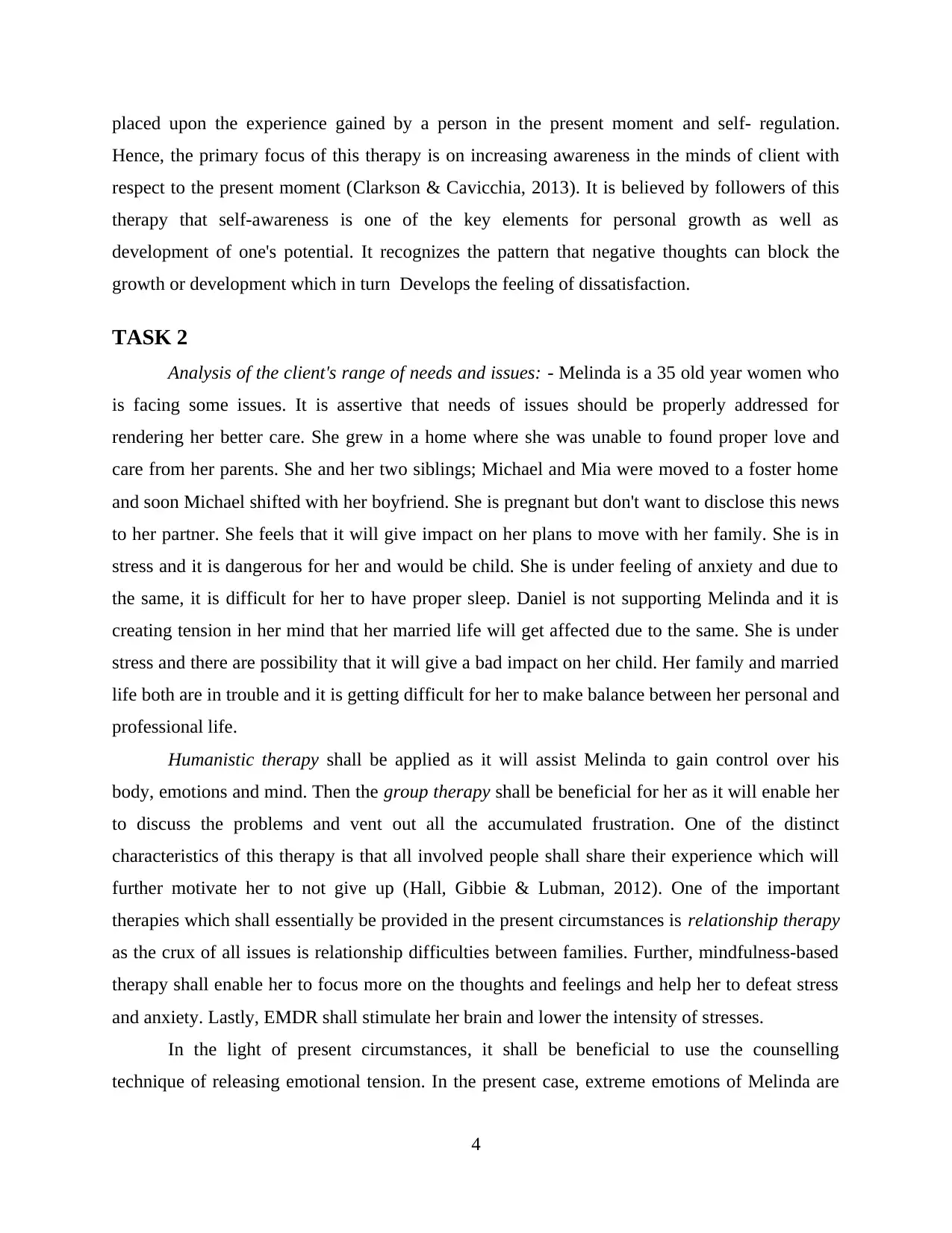
placed upon the experience gained by a person in the present moment and self- regulation.
Hence, the primary focus of this therapy is on increasing awareness in the minds of client with
respect to the present moment (Clarkson & Cavicchia, 2013). It is believed by followers of this
therapy that self-awareness is one of the key elements for personal growth as well as
development of one's potential. It recognizes the pattern that negative thoughts can block the
growth or development which in turn Develops the feeling of dissatisfaction.
TASK 2
Analysis of the client's range of needs and issues: - Melinda is a 35 old year women who
is facing some issues. It is assertive that needs of issues should be properly addressed for
rendering her better care. She grew in a home where she was unable to found proper love and
care from her parents. She and her two siblings; Michael and Mia were moved to a foster home
and soon Michael shifted with her boyfriend. She is pregnant but don't want to disclose this news
to her partner. She feels that it will give impact on her plans to move with her family. She is in
stress and it is dangerous for her and would be child. She is under feeling of anxiety and due to
the same, it is difficult for her to have proper sleep. Daniel is not supporting Melinda and it is
creating tension in her mind that her married life will get affected due to the same. She is under
stress and there are possibility that it will give a bad impact on her child. Her family and married
life both are in trouble and it is getting difficult for her to make balance between her personal and
professional life.
Humanistic therapy shall be applied as it will assist Melinda to gain control over his
body, emotions and mind. Then the group therapy shall be beneficial for her as it will enable her
to discuss the problems and vent out all the accumulated frustration. One of the distinct
characteristics of this therapy is that all involved people shall share their experience which will
further motivate her to not give up (Hall, Gibbie & Lubman, 2012). One of the important
therapies which shall essentially be provided in the present circumstances is relationship therapy
as the crux of all issues is relationship difficulties between families. Further, mindfulness-based
therapy shall enable her to focus more on the thoughts and feelings and help her to defeat stress
and anxiety. Lastly, EMDR shall stimulate her brain and lower the intensity of stresses.
In the light of present circumstances, it shall be beneficial to use the counselling
technique of releasing emotional tension. In the present case, extreme emotions of Melinda are
4
Hence, the primary focus of this therapy is on increasing awareness in the minds of client with
respect to the present moment (Clarkson & Cavicchia, 2013). It is believed by followers of this
therapy that self-awareness is one of the key elements for personal growth as well as
development of one's potential. It recognizes the pattern that negative thoughts can block the
growth or development which in turn Develops the feeling of dissatisfaction.
TASK 2
Analysis of the client's range of needs and issues: - Melinda is a 35 old year women who
is facing some issues. It is assertive that needs of issues should be properly addressed for
rendering her better care. She grew in a home where she was unable to found proper love and
care from her parents. She and her two siblings; Michael and Mia were moved to a foster home
and soon Michael shifted with her boyfriend. She is pregnant but don't want to disclose this news
to her partner. She feels that it will give impact on her plans to move with her family. She is in
stress and it is dangerous for her and would be child. She is under feeling of anxiety and due to
the same, it is difficult for her to have proper sleep. Daniel is not supporting Melinda and it is
creating tension in her mind that her married life will get affected due to the same. She is under
stress and there are possibility that it will give a bad impact on her child. Her family and married
life both are in trouble and it is getting difficult for her to make balance between her personal and
professional life.
Humanistic therapy shall be applied as it will assist Melinda to gain control over his
body, emotions and mind. Then the group therapy shall be beneficial for her as it will enable her
to discuss the problems and vent out all the accumulated frustration. One of the distinct
characteristics of this therapy is that all involved people shall share their experience which will
further motivate her to not give up (Hall, Gibbie & Lubman, 2012). One of the important
therapies which shall essentially be provided in the present circumstances is relationship therapy
as the crux of all issues is relationship difficulties between families. Further, mindfulness-based
therapy shall enable her to focus more on the thoughts and feelings and help her to defeat stress
and anxiety. Lastly, EMDR shall stimulate her brain and lower the intensity of stresses.
In the light of present circumstances, it shall be beneficial to use the counselling
technique of releasing emotional tension. In the present case, extreme emotions of Melinda are
4
⊘ This is a preview!⊘
Do you want full access?
Subscribe today to unlock all pages.

Trusted by 1+ million students worldwide
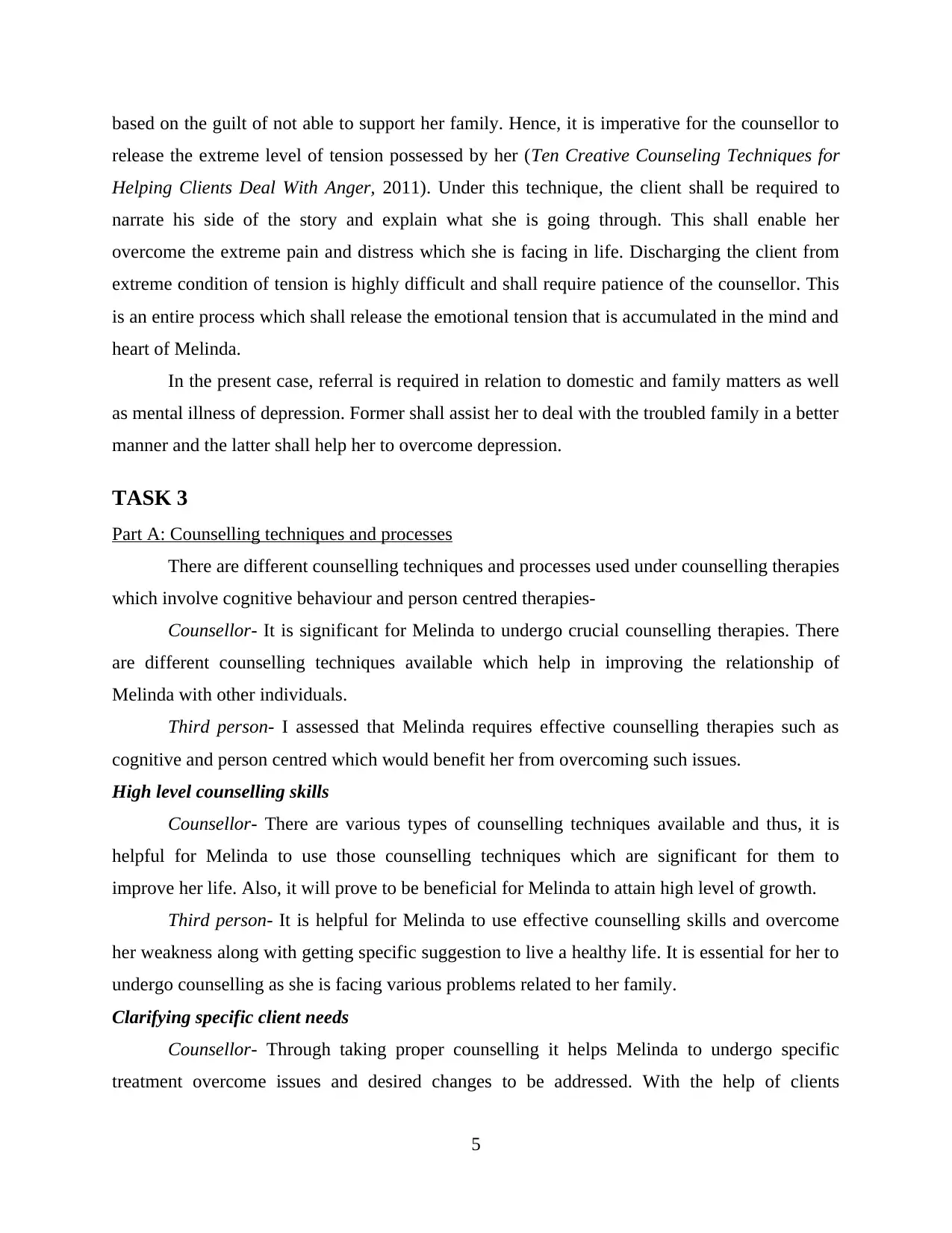
based on the guilt of not able to support her family. Hence, it is imperative for the counsellor to
release the extreme level of tension possessed by her (Ten Creative Counseling Techniques for
Helping Clients Deal With Anger, 2011). Under this technique, the client shall be required to
narrate his side of the story and explain what she is going through. This shall enable her
overcome the extreme pain and distress which she is facing in life. Discharging the client from
extreme condition of tension is highly difficult and shall require patience of the counsellor. This
is an entire process which shall release the emotional tension that is accumulated in the mind and
heart of Melinda.
In the present case, referral is required in relation to domestic and family matters as well
as mental illness of depression. Former shall assist her to deal with the troubled family in a better
manner and the latter shall help her to overcome depression.
TASK 3
Part A: Counselling techniques and processes
There are different counselling techniques and processes used under counselling therapies
which involve cognitive behaviour and person centred therapies-
Counsellor- It is significant for Melinda to undergo crucial counselling therapies. There
are different counselling techniques available which help in improving the relationship of
Melinda with other individuals.
Third person- I assessed that Melinda requires effective counselling therapies such as
cognitive and person centred which would benefit her from overcoming such issues.
High level counselling skills
Counsellor- There are various types of counselling techniques available and thus, it is
helpful for Melinda to use those counselling techniques which are significant for them to
improve her life. Also, it will prove to be beneficial for Melinda to attain high level of growth.
Third person- It is helpful for Melinda to use effective counselling skills and overcome
her weakness along with getting specific suggestion to live a healthy life. It is essential for her to
undergo counselling as she is facing various problems related to her family.
Clarifying specific client needs
Counsellor- Through taking proper counselling it helps Melinda to undergo specific
treatment overcome issues and desired changes to be addressed. With the help of clients
5
release the extreme level of tension possessed by her (Ten Creative Counseling Techniques for
Helping Clients Deal With Anger, 2011). Under this technique, the client shall be required to
narrate his side of the story and explain what she is going through. This shall enable her
overcome the extreme pain and distress which she is facing in life. Discharging the client from
extreme condition of tension is highly difficult and shall require patience of the counsellor. This
is an entire process which shall release the emotional tension that is accumulated in the mind and
heart of Melinda.
In the present case, referral is required in relation to domestic and family matters as well
as mental illness of depression. Former shall assist her to deal with the troubled family in a better
manner and the latter shall help her to overcome depression.
TASK 3
Part A: Counselling techniques and processes
There are different counselling techniques and processes used under counselling therapies
which involve cognitive behaviour and person centred therapies-
Counsellor- It is significant for Melinda to undergo crucial counselling therapies. There
are different counselling techniques available which help in improving the relationship of
Melinda with other individuals.
Third person- I assessed that Melinda requires effective counselling therapies such as
cognitive and person centred which would benefit her from overcoming such issues.
High level counselling skills
Counsellor- There are various types of counselling techniques available and thus, it is
helpful for Melinda to use those counselling techniques which are significant for them to
improve her life. Also, it will prove to be beneficial for Melinda to attain high level of growth.
Third person- It is helpful for Melinda to use effective counselling skills and overcome
her weakness along with getting specific suggestion to live a healthy life. It is essential for her to
undergo counselling as she is facing various problems related to her family.
Clarifying specific client needs
Counsellor- Through taking proper counselling it helps Melinda to undergo specific
treatment overcome issues and desired changes to be addressed. With the help of clients
5
Paraphrase This Document
Need a fresh take? Get an instant paraphrase of this document with our AI Paraphraser
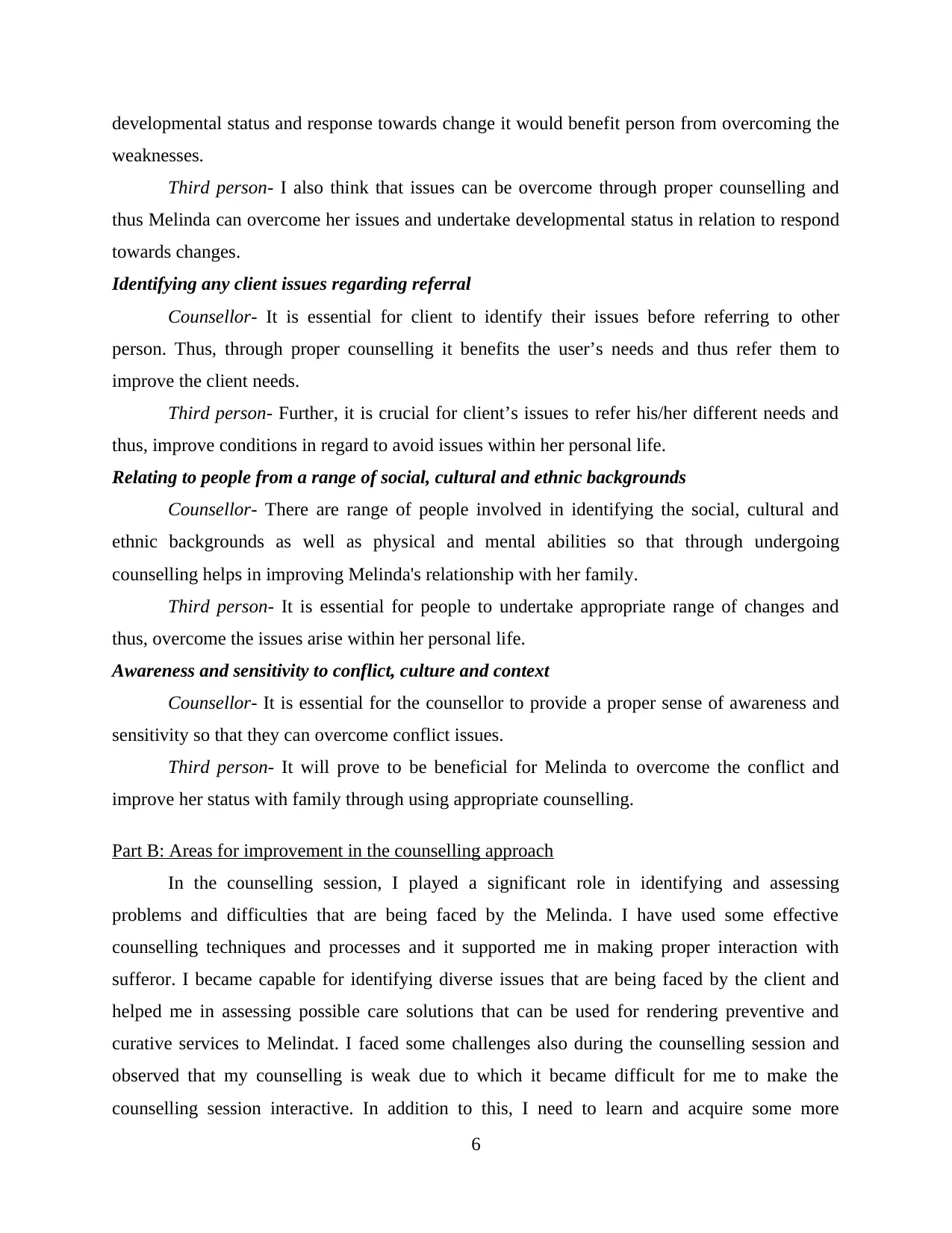
developmental status and response towards change it would benefit person from overcoming the
weaknesses.
Third person- I also think that issues can be overcome through proper counselling and
thus Melinda can overcome her issues and undertake developmental status in relation to respond
towards changes.
Identifying any client issues regarding referral
Counsellor- It is essential for client to identify their issues before referring to other
person. Thus, through proper counselling it benefits the user’s needs and thus refer them to
improve the client needs.
Third person- Further, it is crucial for client’s issues to refer his/her different needs and
thus, improve conditions in regard to avoid issues within her personal life.
Relating to people from a range of social, cultural and ethnic backgrounds
Counsellor- There are range of people involved in identifying the social, cultural and
ethnic backgrounds as well as physical and mental abilities so that through undergoing
counselling helps in improving Melinda's relationship with her family.
Third person- It is essential for people to undertake appropriate range of changes and
thus, overcome the issues arise within her personal life.
Awareness and sensitivity to conflict, culture and context
Counsellor- It is essential for the counsellor to provide a proper sense of awareness and
sensitivity so that they can overcome conflict issues.
Third person- It will prove to be beneficial for Melinda to overcome the conflict and
improve her status with family through using appropriate counselling.
Part B: Areas for improvement in the counselling approach
In the counselling session, I played a significant role in identifying and assessing
problems and difficulties that are being faced by the Melinda. I have used some effective
counselling techniques and processes and it supported me in making proper interaction with
sufferor. I became capable for identifying diverse issues that are being faced by the client and
helped me in assessing possible care solutions that can be used for rendering preventive and
curative services to Melindat. I faced some challenges also during the counselling session and
observed that my counselling is weak due to which it became difficult for me to make the
counselling session interactive. In addition to this, I need to learn and acquire some more
6
weaknesses.
Third person- I also think that issues can be overcome through proper counselling and
thus Melinda can overcome her issues and undertake developmental status in relation to respond
towards changes.
Identifying any client issues regarding referral
Counsellor- It is essential for client to identify their issues before referring to other
person. Thus, through proper counselling it benefits the user’s needs and thus refer them to
improve the client needs.
Third person- Further, it is crucial for client’s issues to refer his/her different needs and
thus, improve conditions in regard to avoid issues within her personal life.
Relating to people from a range of social, cultural and ethnic backgrounds
Counsellor- There are range of people involved in identifying the social, cultural and
ethnic backgrounds as well as physical and mental abilities so that through undergoing
counselling helps in improving Melinda's relationship with her family.
Third person- It is essential for people to undertake appropriate range of changes and
thus, overcome the issues arise within her personal life.
Awareness and sensitivity to conflict, culture and context
Counsellor- It is essential for the counsellor to provide a proper sense of awareness and
sensitivity so that they can overcome conflict issues.
Third person- It will prove to be beneficial for Melinda to overcome the conflict and
improve her status with family through using appropriate counselling.
Part B: Areas for improvement in the counselling approach
In the counselling session, I played a significant role in identifying and assessing
problems and difficulties that are being faced by the Melinda. I have used some effective
counselling techniques and processes and it supported me in making proper interaction with
sufferor. I became capable for identifying diverse issues that are being faced by the client and
helped me in assessing possible care solutions that can be used for rendering preventive and
curative services to Melindat. I faced some challenges also during the counselling session and
observed that my counselling is weak due to which it became difficult for me to make the
counselling session interactive. In addition to this, I need to learn and acquire some more
6
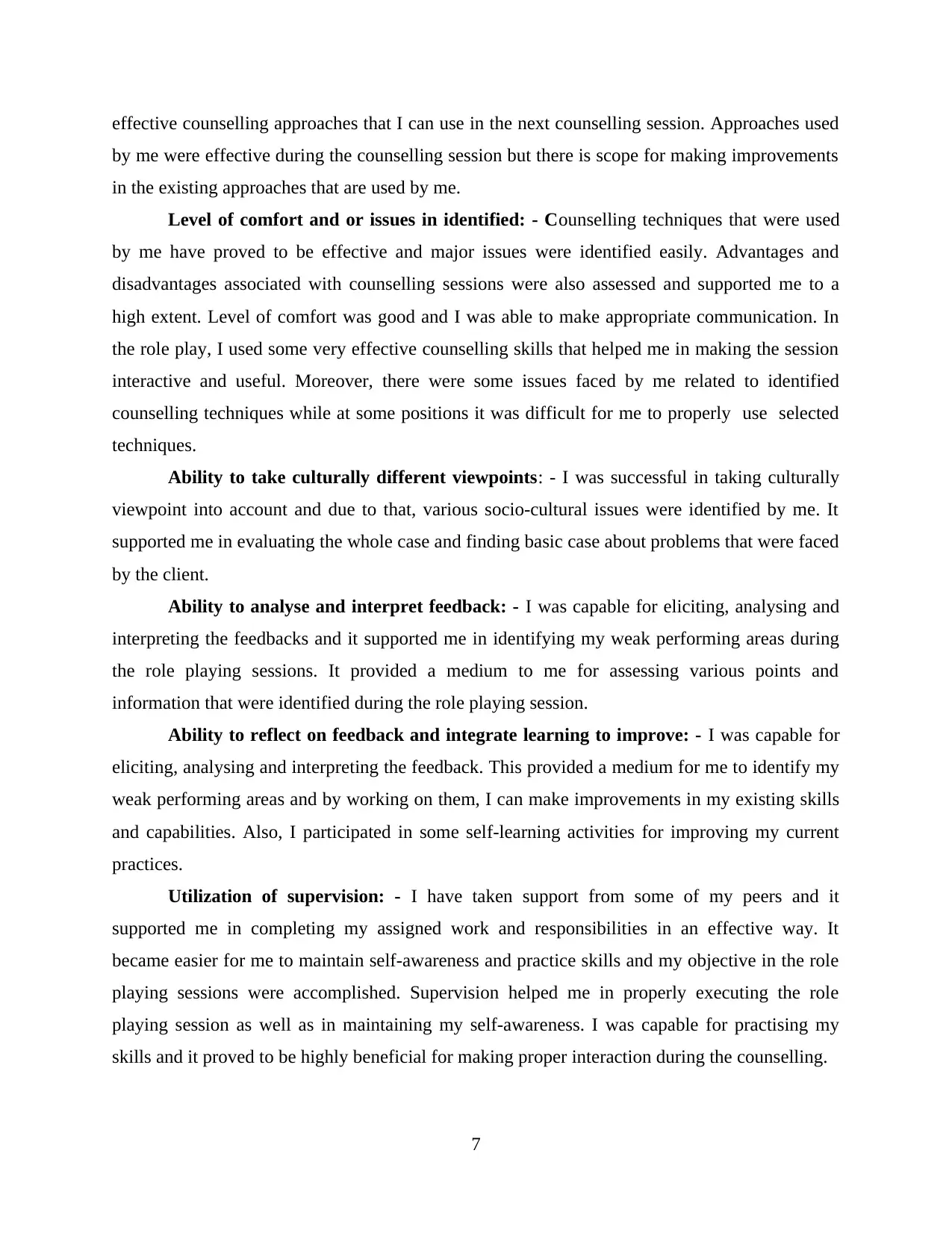
effective counselling approaches that I can use in the next counselling session. Approaches used
by me were effective during the counselling session but there is scope for making improvements
in the existing approaches that are used by me.
Level of comfort and or issues in identified: - Counselling techniques that were used
by me have proved to be effective and major issues were identified easily. Advantages and
disadvantages associated with counselling sessions were also assessed and supported me to a
high extent. Level of comfort was good and I was able to make appropriate communication. In
the role play, I used some very effective counselling skills that helped me in making the session
interactive and useful. Moreover, there were some issues faced by me related to identified
counselling techniques while at some positions it was difficult for me to properly use selected
techniques.
Ability to take culturally different viewpoints: - I was successful in taking culturally
viewpoint into account and due to that, various socio-cultural issues were identified by me. It
supported me in evaluating the whole case and finding basic case about problems that were faced
by the client.
Ability to analyse and interpret feedback: - I was capable for eliciting, analysing and
interpreting the feedbacks and it supported me in identifying my weak performing areas during
the role playing sessions. It provided a medium to me for assessing various points and
information that were identified during the role playing session.
Ability to reflect on feedback and integrate learning to improve: - I was capable for
eliciting, analysing and interpreting the feedback. This provided a medium for me to identify my
weak performing areas and by working on them, I can make improvements in my existing skills
and capabilities. Also, I participated in some self-learning activities for improving my current
practices.
Utilization of supervision: - I have taken support from some of my peers and it
supported me in completing my assigned work and responsibilities in an effective way. It
became easier for me to maintain self-awareness and practice skills and my objective in the role
playing sessions were accomplished. Supervision helped me in properly executing the role
playing session as well as in maintaining my self-awareness. I was capable for practising my
skills and it proved to be highly beneficial for making proper interaction during the counselling.
7
by me were effective during the counselling session but there is scope for making improvements
in the existing approaches that are used by me.
Level of comfort and or issues in identified: - Counselling techniques that were used
by me have proved to be effective and major issues were identified easily. Advantages and
disadvantages associated with counselling sessions were also assessed and supported me to a
high extent. Level of comfort was good and I was able to make appropriate communication. In
the role play, I used some very effective counselling skills that helped me in making the session
interactive and useful. Moreover, there were some issues faced by me related to identified
counselling techniques while at some positions it was difficult for me to properly use selected
techniques.
Ability to take culturally different viewpoints: - I was successful in taking culturally
viewpoint into account and due to that, various socio-cultural issues were identified by me. It
supported me in evaluating the whole case and finding basic case about problems that were faced
by the client.
Ability to analyse and interpret feedback: - I was capable for eliciting, analysing and
interpreting the feedbacks and it supported me in identifying my weak performing areas during
the role playing sessions. It provided a medium to me for assessing various points and
information that were identified during the role playing session.
Ability to reflect on feedback and integrate learning to improve: - I was capable for
eliciting, analysing and interpreting the feedback. This provided a medium for me to identify my
weak performing areas and by working on them, I can make improvements in my existing skills
and capabilities. Also, I participated in some self-learning activities for improving my current
practices.
Utilization of supervision: - I have taken support from some of my peers and it
supported me in completing my assigned work and responsibilities in an effective way. It
became easier for me to maintain self-awareness and practice skills and my objective in the role
playing sessions were accomplished. Supervision helped me in properly executing the role
playing session as well as in maintaining my self-awareness. I was capable for practising my
skills and it proved to be highly beneficial for making proper interaction during the counselling.
7
⊘ This is a preview!⊘
Do you want full access?
Subscribe today to unlock all pages.

Trusted by 1+ million students worldwide
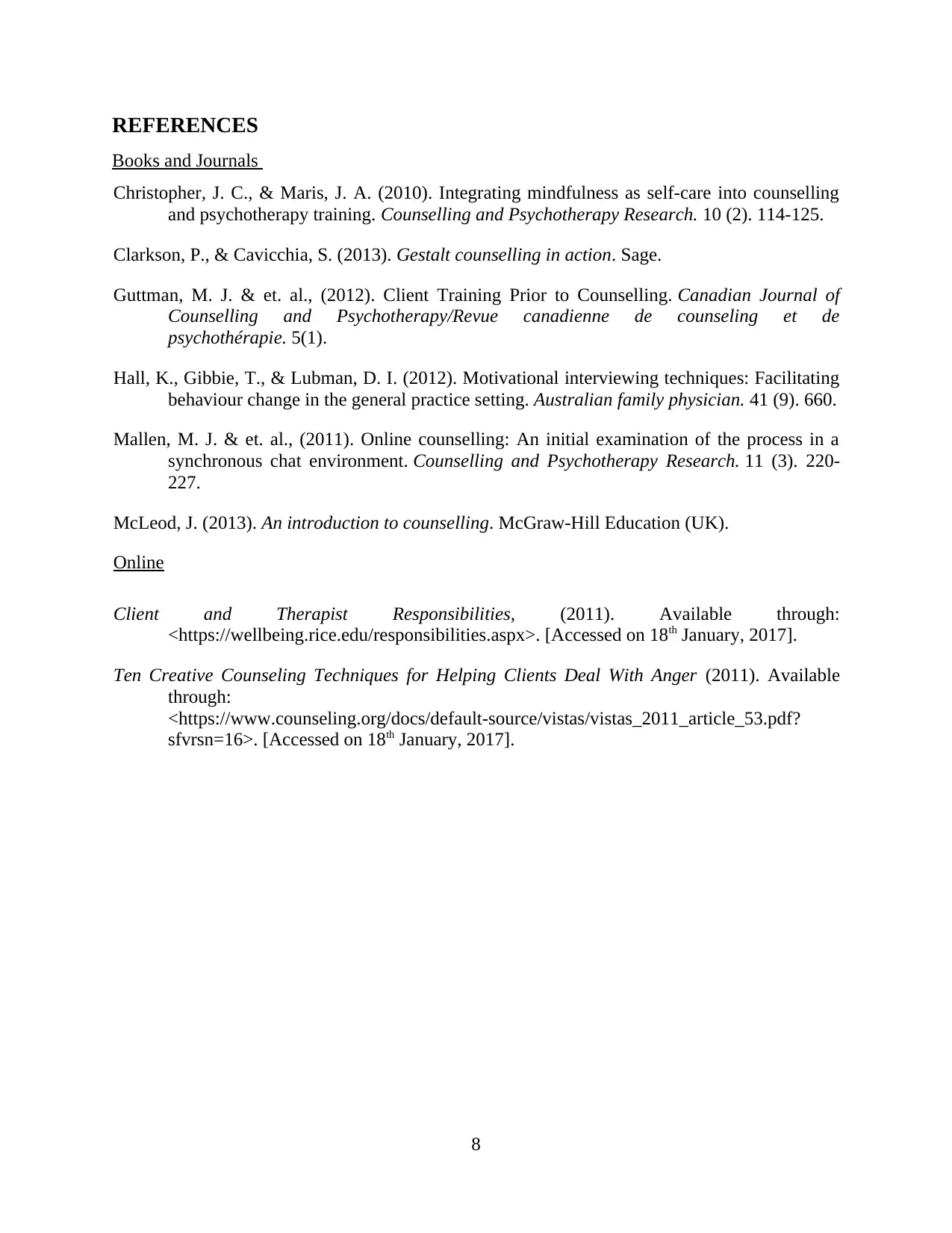
REFERENCES
Books and Journals
Christopher, J. C., & Maris, J. A. (2010). Integrating mindfulness as self-care into counselling
and psychotherapy training. Counselling and Psychotherapy Research. 10 (2). 114-125.
Clarkson, P., & Cavicchia, S. (2013). Gestalt counselling in action. Sage.
Guttman, M. J. & et. al., (2012). Client Training Prior to Counselling. Canadian Journal of
Counselling and Psychotherapy/Revue canadienne de counseling et de
psychothérapie. 5(1).
Hall, K., Gibbie, T., & Lubman, D. I. (2012). Motivational interviewing techniques: Facilitating
behaviour change in the general practice setting. Australian family physician. 41 (9). 660.
Mallen, M. J. & et. al., (2011). Online counselling: An initial examination of the process in a
synchronous chat environment. Counselling and Psychotherapy Research. 11 (3). 220-
227.
McLeod, J. (2013). An introduction to counselling. McGraw-Hill Education (UK).
Online
Client and Therapist Responsibilities, (2011). Available through:
<https://wellbeing.rice.edu/responsibilities.aspx>. [Accessed on 18th January, 2017].
Ten Creative Counseling Techniques for Helping Clients Deal With Anger (2011). Available
through:
<https://www.counseling.org/docs/default-source/vistas/vistas_2011_article_53.pdf?
sfvrsn=16>. [Accessed on 18th January, 2017].
8
Books and Journals
Christopher, J. C., & Maris, J. A. (2010). Integrating mindfulness as self-care into counselling
and psychotherapy training. Counselling and Psychotherapy Research. 10 (2). 114-125.
Clarkson, P., & Cavicchia, S. (2013). Gestalt counselling in action. Sage.
Guttman, M. J. & et. al., (2012). Client Training Prior to Counselling. Canadian Journal of
Counselling and Psychotherapy/Revue canadienne de counseling et de
psychothérapie. 5(1).
Hall, K., Gibbie, T., & Lubman, D. I. (2012). Motivational interviewing techniques: Facilitating
behaviour change in the general practice setting. Australian family physician. 41 (9). 660.
Mallen, M. J. & et. al., (2011). Online counselling: An initial examination of the process in a
synchronous chat environment. Counselling and Psychotherapy Research. 11 (3). 220-
227.
McLeod, J. (2013). An introduction to counselling. McGraw-Hill Education (UK).
Online
Client and Therapist Responsibilities, (2011). Available through:
<https://wellbeing.rice.edu/responsibilities.aspx>. [Accessed on 18th January, 2017].
Ten Creative Counseling Techniques for Helping Clients Deal With Anger (2011). Available
through:
<https://www.counseling.org/docs/default-source/vistas/vistas_2011_article_53.pdf?
sfvrsn=16>. [Accessed on 18th January, 2017].
8
1 out of 10
Related Documents
Your All-in-One AI-Powered Toolkit for Academic Success.
+13062052269
info@desklib.com
Available 24*7 on WhatsApp / Email
![[object Object]](/_next/static/media/star-bottom.7253800d.svg)
Unlock your academic potential
Copyright © 2020–2025 A2Z Services. All Rights Reserved. Developed and managed by ZUCOL.




